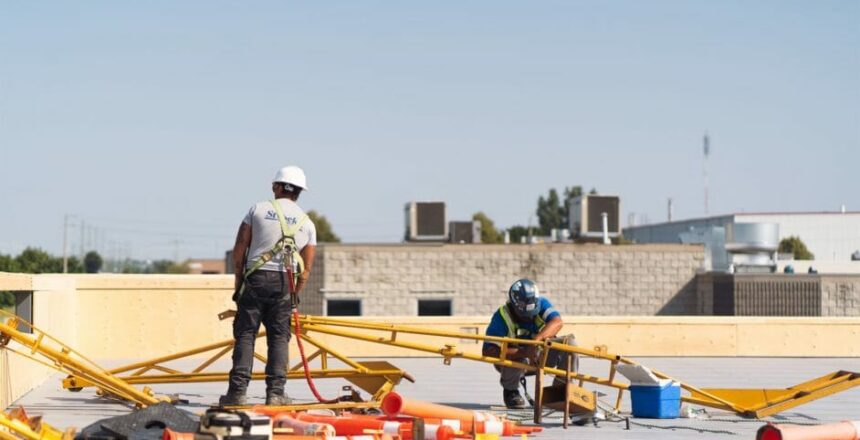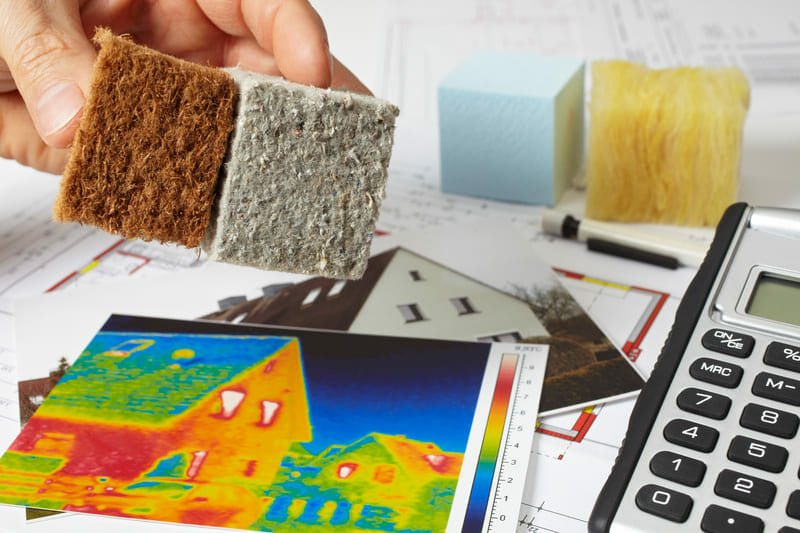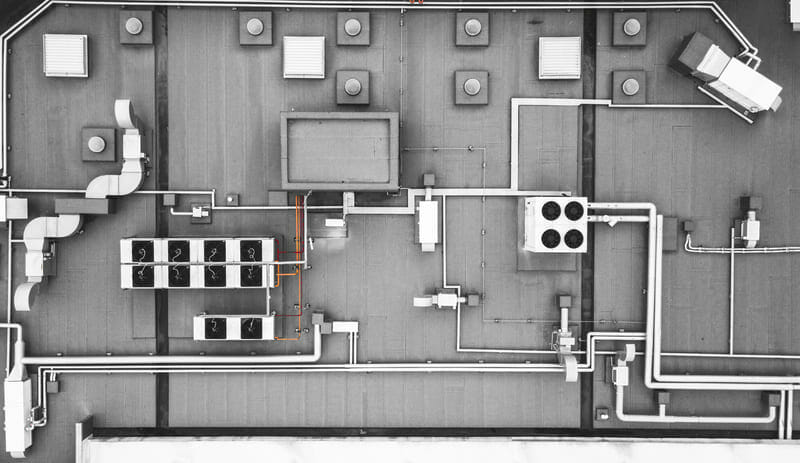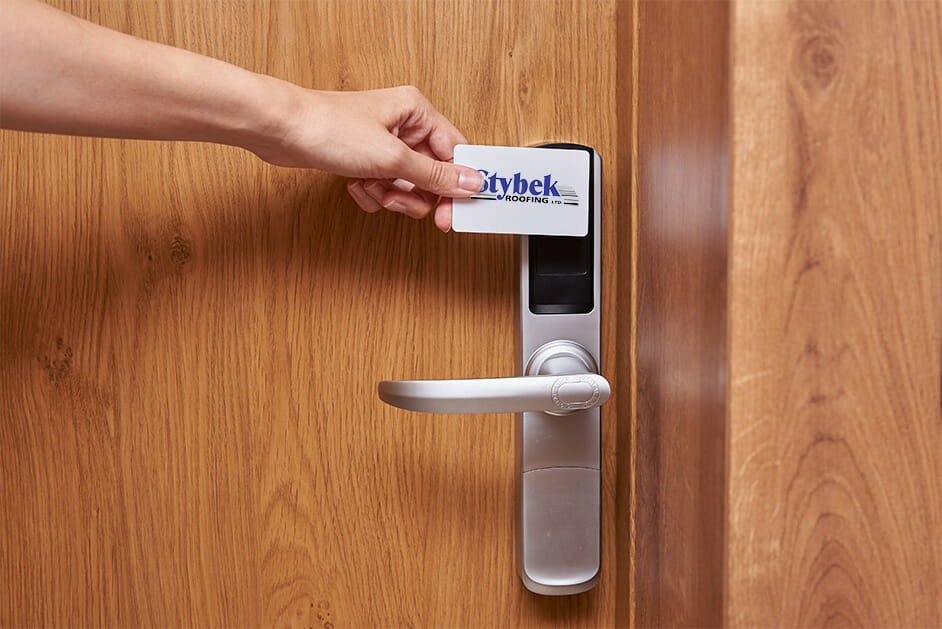If you own a business, your roof does more than keep out the rain. With the proper care and maintenance, it also reduces energy costs, saves you money, and sends your curb appeal through the roof- pun intended.
So why is your commercial roof the last thing on your mind until something goes wrong?
It’s basically the old principle of ‘out of sight, out of mind. If you can’t see something, it’s hard to know when problems are developing. It’s not just building owners who make this mistake: even property managers don’t always go on the roof until it starts leaking and they’ve got no choice. By that point, it’s usually too late to avoid a huge repair bill.
At Stybek Roofing, we’re always responding to commercial roofing emergencies that could have been prevented if the business owner understood more about what roof type to install and how to maintain it. This is why we’re outlining key questions to ask your commercial roofer about roof installation and maintenance.
Question #1: How long have you been in business?
In general, the longer a commercial roofer has been in business, the more experience they will have in working with different types of roofs (for example, single-ply vs. built-up roofing). You want to work with a company that knows the unique challenges of different roofing styles and materials and can troubleshoot any issues the first time around.
Question #2: Which systems do you specialize in?
All roof systems serve a purpose depending on the application. Let’s take a look at the most common types.
- Single-ply, which is wide-width sheeting meant for low slope and flat roofs. The top three single-ply materials are thermoplastic polyolefin (TPO), polyvinyl chloride (PVC), and ethylene propylene diene terpolymer (EPDM).
- Two-ply roofing consists of two-ply modified bitumen. They can be installed cold or hot and are considered a tougher system.
- Built-up roofing (BUR) consists of layers of tar, coal tar, reinforcing fabrics, and bitumen (asphalt), covered with a top layer of stone or gravel. We’ve noticed a slight decline in BUR systems due to the mess and smell created when asphalt is heated up .
BUR and modified bitumen advocates may argue that single-ply systems are inferior. In terms of strength, we think that’s accurate in terms of the science, but single-ply systems have their purpose.
For example, if you own a warehouse that doesn’t have any surrounding trees or buildings and there are only a few HVAC systems on the roof, you can go single-ply because it’s cost-effective and there’s nothing around it that can inflict damage.
It’s a different story if you own a downtown apartment building surrounded by trees and tall structures. There could be overhanging balconies where residents throw beer bottles onto your roof at 2:00 a.m. or trees with weak branches that break off and fall onto the roof during a good wind storm.
In this case, you’re going to want a two-ply system or built-up roofing, which is typically a four-ply system. If you go with single-ply because it’s cheaper and easier to put on, it won’t be long before you’ve got leaks and other issues that require expensive repairs.
Question #3: How old is my roof and what kind of system is it?
These are technical details that can dictate best practices for maintenance as well as help you put together an inspection schedule. An older single-ply roofing system in downtown Toronto is likely going to need more attention than a BUR system that’s only a couple years old.
There are certain things you can look for when trying to determine the age of a roof. For example, if you have a TPO roof, is it oxidized? Are there ridges or creases? Is there blistering or bubbling? Is there tenting at the perimeter?
Buildings in Canada expand and contract over the course of the season, and the resulting temperature fluctuations can affect the membrane. Things like creasing and oxidation will give you indicators as to how old that system may be.
Question #4: Who installed my roof?
There are certain indicators that can tell you which company installed your roof. If you go up the ladder to the hatch, you’ll typically see a sticker placed by the original installer, which usually has their company markings and logos. Once you get on the roof, you can look at the flat roof drains: they usually have a dome over them with the company name in the center. Of course, the most obvious answer may be that you still have the original manufacturer warranty.
Question #5: Does drainage appear to be operating properly?
If you’ve got a flat roof that’s around 1000 square feet, there should be multiple drains installed within that area. Depending on the structure and purpose of the building itself, you might need even more to prevent issues like standing water, which can speed up roof deterioration.
Question #6: Are there any redundant penetrations that can be removed?
Imagine that you’ve leased a space on a commercial property that used to be a Burrito Boys. You’re opening a jewelry shop, so you don’t need all the venting that was used for their stove exhaust. On a flat roof, penetrations like this are typically a weak point and considered redundant. Removing it when it’s not needed can prevent problems in the future.
Question #7: Should I install a roof walkway?
When you have high traffic levels on your roof, a walkway may make sense. For example If you have a 10,000 square foot single-ply roof with 20 HVAC units on it, you can expect a lot of traffic from HVAC techs doing repairs or routine maintenance. To protect the single-ply membrane, a walkway is recommended. The same would apply for a modified bitumen roof system. Continuous traffic overtime can displace the granules imbedded in the cap sheet membrane
Question #8: What condition are my metal flashings in?
All roof systems have metal flashings. Sometimes they come loose over time and even blow away during wind storms. You want your commercial roofer to inspect your metal flashings and secure them to eliminate safety risks. If a piece breaks away and falls 20 to 40 feet, it could seriously injure or even kill someone.
Question #9: What should I know about metal roofing?
With a metal roof, you generally look for the same issues that you would with any other: the primary difference is that metal roofs are usually low-slope. You should know what type of system it is and check for signs of aging, deterioration, or damage.
In cases where the sealant between the panels is deteriorating, repairs were likely done past the coatings or membranes. If you didn’t own the building when this happened, your commercial roofer can take a closer look and confirm that the repairs are still doing their job.
Question #10: Should my roof warranty still be good?
There are two types of warranties you should be aware of: a warranty on workmanship and the manufacturer warranty.
If you replace your roof, the commercial roofer will usually hold a two-year warranty on it. If something goes wrong and it’s workmanship-related, Stybek or whatever commercial roofer did the work will typically cover the cost.
A manufacturer warranty usually starts at five years and can go all the way up to 30+ years. The number of years correlates with the material used. A roof with a five-year warranty will be installed with cheaper or less strict material than one with a 30+-year warranty.
If you don’t know who the manufacturer is, we often can tell based on what we see during a commercial roofing inspection. We’ll go up there and, for example, determine that it’s a Firestone roof installed around 10 to 12 years ago. Once the manufacturer is identified, it’s easier to find out what kind of warranty was in place and whether it’s still valid.
Question #11: Why are commercial roof repairs more expensive than residential?
Most people compare commercial to residential. Replacing the shingles on your average 2500-square-foot house might cost anywhere from $2500 to $4500. Commercial is different, so if you have any questions about cost, ask them.
At Stybek, we usually say something like, “OK, we’d love to help you. What’s your budget and we’ll tell you whether it will or will not work.” Educating people is the best way to achieve a result that everyone’s happy with.
Do You Have Questions for a Commercial Roofer?
Keeping your roof in good shape calls for partnership between yourself and an experienced commercial roofer who’s willing to educate you. While expertise in roofing is definitely not a prerequisite to owning a business, a little knowledge goes a long way toward keeping the structure sound and saving you money.
When business owners in and around Southwestern Ontario need answers to their roofing questions, they call Stybek Roofing. We have been installing, maintaining, and repairing roofs for commercial buildings since 1991 and are happy to educate you on the best options for your roofing needs. You can schedule an inspection with one of our licensed, certified, and insured technicians by calling 519-888-9676 or contacting us online. Our company offers competitive prices, honest recommendations, and a satisfaction guarantee.





